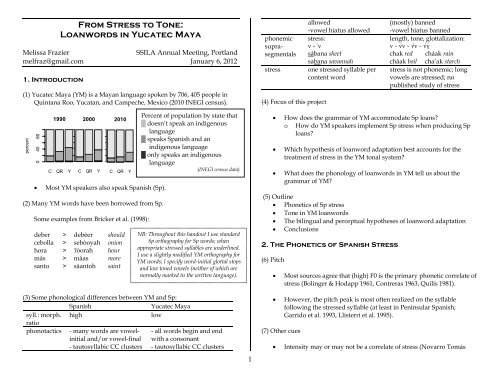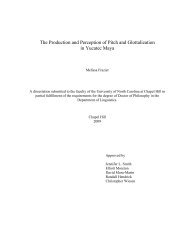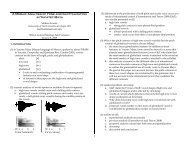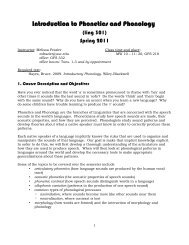From Stress to Tone: Loanwords in Yucatec Maya - Melfraz.com
From Stress to Tone: Loanwords in Yucatec Maya - Melfraz.com
From Stress to Tone: Loanwords in Yucatec Maya - Melfraz.com
You also want an ePaper? Increase the reach of your titles
YUMPU automatically turns print PDFs into web optimized ePapers that Google loves.
<strong>From</strong> <strong>Stress</strong> <strong>to</strong> <strong>Tone</strong>:<br />
<strong>Loanwords</strong> <strong>in</strong> <strong>Yucatec</strong> <strong>Maya</strong><br />
Melissa Frazier SSILA Annual Meet<strong>in</strong>g, Portland<br />
melfraz@gmail.<strong>com</strong> January 6, 2012<br />
1. Introduction<br />
(1) <strong>Yucatec</strong> <strong>Maya</strong> (YM) is a <strong>Maya</strong>n language spoken by 706, 405 people <strong>in</strong><br />
Qu<strong>in</strong>tana Roo, Yucatan, and Campeche, Mexico (2010 INEGI census).<br />
percent<br />
0 40 80<br />
1990<br />
C QR Y<br />
2000<br />
C QR Y<br />
2010<br />
C QR Y<br />
• Most YM speakers also speak Spanish (Sp).<br />
(2) Many YM words have been borrowed from Sp.<br />
Some examples from Bricker et al. (1998):<br />
deber > debèer should<br />
cebolla > sebòoyah onion<br />
hora > ʔòorah hour<br />
más > màas more<br />
san<strong>to</strong> > sàan<strong>to</strong>h sa<strong>in</strong>t<br />
Percent of population by state that<br />
█ doesn’t speak an <strong>in</strong>digenous<br />
language<br />
█ speaks Spanish and an<br />
<strong>in</strong>digenous language<br />
█ only speaks an <strong>in</strong>digenous<br />
language<br />
(INEGI census data)<br />
NB: Throughout this handout I use standard<br />
Sp orthography for Sp words; when<br />
appropriate stressed syllables are underl<strong>in</strong>ed.<br />
I use a slightly modified YM orthography for<br />
YM words; I specify word-<strong>in</strong>itial glottal s<strong>to</strong>ps<br />
and low <strong>to</strong>ned vowels (neither of which are<br />
normally marked <strong>in</strong> the written language).<br />
(3) Some phonological differences between YM and Sp:<br />
Spanish <strong>Yucatec</strong> <strong>Maya</strong><br />
syll.: morph.<br />
ratio<br />
high low<br />
phonotactics - many words are vowel- - all words beg<strong>in</strong> and end<br />
<strong>in</strong>itial and/or vowel-f<strong>in</strong>al with a consonant<br />
- tau<strong>to</strong>syllabic CC clusters - tau<strong>to</strong>syllabic CC clusters<br />
1<br />
allowed<br />
-vowel hiatus allowed<br />
phonemic stress:<br />
supra- v ~ ˈv<br />
segmentals sábana sheet<br />
sabana savannah<br />
stress one stressed syllable per<br />
content word<br />
(4) Focus of this project<br />
(mostly) banned<br />
-vowel hiatus banned<br />
length, <strong>to</strong>ne, glottalization:<br />
v ~ v́v ~ v̀v ~ v́v̰<br />
chak red cháak ra<strong>in</strong><br />
chàak boil cha’ak starch<br />
stress is not phonemic; long<br />
vowels are stressed; no<br />
published study of stress<br />
• How does the grammar of YM ac<strong>com</strong>modate Sp loans?<br />
o How do YM speakers implement Sp stress when produc<strong>in</strong>g Sp<br />
loans?<br />
• Which hypothesis of loanword adaptation best accounts for the<br />
treatment of stress <strong>in</strong> the YM <strong>to</strong>nal system?<br />
• What does the phonology of loanwords <strong>in</strong> YM tell us about the<br />
grammar of YM?<br />
(5) Outl<strong>in</strong>e<br />
• Phonetics of Sp stress<br />
• <strong>Tone</strong> <strong>in</strong> YM loanwords<br />
• The bil<strong>in</strong>gual and perceptual hypotheses of loanword adaptation<br />
• Conclusions<br />
2. The Phonetics of Spanish <strong>Stress</strong><br />
(6) Pitch<br />
• Most sources agree that (high) F0 is the primary phonetic correlate of<br />
stress (Bol<strong>in</strong>ger & Hodapp 1961, Contreras 1963, Quilis 1981).<br />
• However, the pitch peak is most often realized on the syllable<br />
follow<strong>in</strong>g the stressed syllable (at least <strong>in</strong> Pen<strong>in</strong>sular Spanish;<br />
Garrido et al. 1993, Llisterri et al. 1995).<br />
(7) Other cues<br />
• Intensity may or may not be a correlate of stress (Novarro Tomás
(1967) says it is; others overlook it).<br />
• Duration is not a correlate of stress <strong>in</strong> Mexican Spanish (all vowels<br />
are about the same length, though post-stress vowels tend <strong>to</strong> be<br />
longer; Samões 1996).<br />
(8) Summary<br />
• The only consistent phonetic correlate of stress is high pitch, with the<br />
pitch peak generally <strong>in</strong> post-stress position.<br />
• Prediction:<br />
o If YM speakers are <strong>in</strong>terpret<strong>in</strong>g the pitch associated with stress<br />
as <strong>to</strong>ne, they should produce either stressed or post-stressed<br />
syllables with high <strong>to</strong>ne.<br />
3. Production of <strong>Loanwords</strong><br />
(9) There is little <strong>in</strong>formation <strong>in</strong> pr<strong>in</strong>t regard<strong>in</strong>g the production of loanwords<br />
<strong>in</strong> YM.<br />
(10) Hanks (1984):<br />
“Contrary <strong>to</strong> what one might expect, primary stress <strong>in</strong> Spanish<br />
loans is usually not assigned high <strong>to</strong>ne <strong>in</strong> <strong>Yucatec</strong>, not at least by<br />
speakers of <strong>Yucatec</strong> as a first language. The general rules appear<br />
<strong>to</strong> be as follows: Span primary stress be<strong>com</strong>es low <strong>to</strong>ne; secondary<br />
or unstressed <strong>in</strong> Span be<strong>com</strong>es high <strong>to</strong>ne <strong>in</strong> <strong>Yucatec</strong>. This gives a<br />
dist<strong>in</strong>ctly foreign sound <strong>to</strong> Span words <strong>in</strong> <strong>Yucatec</strong>. Hence:<br />
familia faámìilyáah<br />
escuela ‘eéskwèeláah<br />
ahora ‘aáwrah<br />
tacos tàakos<br />
amigo ‘aámigóoh “<br />
(orig<strong>in</strong>al emphasis, abbreviations, and transcriptions)<br />
(11) Is this description generally true?<br />
• Phonological data from Bricker et al. (1998)<br />
• Phonetic data from Blair and Vermont Salas (1965)<br />
2<br />
3.1 Data from Bricker et al.<br />
(12) 96 loanwords from Spanish are <strong>in</strong>cluded <strong>in</strong> the dictionary.<br />
• Excludes those whose orig<strong>in</strong> is marked with a question mark.<br />
• Most are proper names or names of (parts of) plants.<br />
• Each loanword coded for relevant properties (grammatical category,<br />
number of syllables, position of Sp. stress, <strong>to</strong>nal realization of stress,<br />
etc.).<br />
(13) <strong>Stress</strong>ed syllables tend <strong>to</strong> be produced with low <strong>to</strong>ne.<br />
• 50% stress > low <strong>to</strong>ne (almúd > mùut ‘measure’)<br />
• 11% stress > high <strong>to</strong>ne (hierba > yéerbah ‘type of plant’)<br />
• 11% stress > no <strong>to</strong>ne (arroz > ʔáaros ‘rice’)<br />
• 27% stressed syllable not present (cucaracha > kùuruch<br />
‘cockroach’)<br />
(14) Many one- and two-syllable words are clipp<strong>in</strong>gs of proper names.<br />
some clipp<strong>in</strong>gs <strong>in</strong>clude the stressed syllable: some do not:<br />
Lázaro > làas Jac<strong>in</strong><strong>to</strong> > hàas<br />
Ernes<strong>to</strong> > nèe<strong>to</strong>h Inocencio > ʔí<strong>in</strong>os<br />
(15) Patterns by number of syllables <strong>in</strong> YM word:<br />
number of syllables<br />
<strong>to</strong>ne <strong>in</strong> YM 1 2 3 4<br />
high <strong>to</strong>ne 0 8 (20%) 2 (13%) 1 (17%)<br />
low <strong>to</strong>ne 13 (38%) 22 (54%) 9 (60%) 4 (67%)<br />
no <strong>to</strong>ne 0 6 (15%) 4 (27%) 1 (17%)<br />
not present 21 (62%) 5 (12%) 0 0<br />
<strong>to</strong>tal 34 41 15 6<br />
• 5 of 6 four-syllable words have <strong>to</strong>ne on the first and third syllables.<br />
aderezo > ʔáaderèesoh Cissampelos pareira L.<br />
agrimonia > ʔáagremòonyoh Teucrium cubense<br />
artemisa > ʔáalkanìisah Artemisia herb<br />
orégano > ʔóoregàanoh wild oregano<br />
albahaca > ʔáalbaháakah Ocimum basilicum L.
(16) Placement of Sp. stress does not <strong>in</strong>fluence <strong>to</strong>ne:<br />
placement of Spanish stress<br />
<strong>to</strong>ne <strong>in</strong> YM antepenult penult ultimate<br />
high <strong>to</strong>ne 2 (25%) 9 (13%) 0<br />
low <strong>to</strong>ne 4 (50%) 34 (50%) 10 (50%)<br />
no <strong>to</strong>ne 2 (25%) 4 (6%) 5 (25%)<br />
not present 0 21 (31%) 5 (25%)<br />
<strong>to</strong>tal 8 68 20<br />
(17) Summary<br />
• <strong>Stress</strong> tends <strong>to</strong> be replaced with low <strong>to</strong>ne.<br />
o When not replaced with low <strong>to</strong>ne, it is equally likely <strong>to</strong> be<br />
replaced with high <strong>to</strong>ne or no <strong>to</strong>ne.<br />
o High <strong>to</strong>ne tends <strong>to</strong> occur two syllables before low <strong>to</strong>ne.<br />
• Absolutes:<br />
o No loanword has high <strong>to</strong>ne on the syllable follow<strong>in</strong>g the Sp<br />
stressed syllable.<br />
o No loanword has a glottalized vowel.<br />
o Every loanword has at least one <strong>to</strong>ned syllable.<br />
• Hanks is correct that stress tends <strong>to</strong> be replaced with low <strong>to</strong>ne<br />
(though this is not an absolute), but there is no general pattern of<br />
plac<strong>in</strong>g high <strong>to</strong>ne on all other syllables.<br />
3.2 Data from Blair & Vermont Salas<br />
(18) Methods<br />
• Measurements taken from record<strong>in</strong>gs on the language learn<strong>in</strong>g CDs<br />
that ac<strong>com</strong>pany Blair and Vermont Salas (1965).<br />
o Almost all Spanish loans used <strong>in</strong> the CDs are proper names; the<br />
exceptions are numbers and function words (the latter not<br />
reported here).<br />
• Vermont Salas is the speaker<br />
o Production of <strong>to</strong>ne <strong>in</strong> native words (see Frazier 2009):<br />
3<br />
low <strong>to</strong>ne high <strong>to</strong>ne<br />
• PRAAT used <strong>to</strong> demarcate vowels and measure pitch <strong>in</strong> all available<br />
Spanish loans <strong>in</strong> the first four lessons<br />
(19) Results for vowel length (ms; long vowels underl<strong>in</strong>ed):<br />
word n pre-a.p. antepen. penult ultimate<br />
Sp. antepenult stress:<br />
México 2 176 51 69<br />
Sp. penult stress:<br />
Alber<strong>to</strong> 6 114 68 87<br />
castellano 6 92 63 138 51<br />
Chicago 7 46 169 64<br />
c<strong>in</strong>co 3 261 79<br />
cuatro 2 133 80<br />
estados 6 67 138 75<br />
Julio 8 155 62<br />
Luisa 6 88 92 90<br />
Marcel<strong>in</strong>o 8 88 57 132 61<br />
Margarita 6 83 80 127 67<br />
Pablo 4 190 59<br />
Pedro 8 164 57<br />
unidos 6 56 118 79<br />
Sp. ultimate stress:<br />
David 6 77 75<br />
Jose 6 70 89<br />
Juan 12 142<br />
Yucatan 2 89 67 177<br />
• Sp stress > long vowel<br />
o exceptions: Alber<strong>to</strong>, Luisa, David, José<br />
o Luisa is not an exception if [ui] is treated as a diphthong<br />
• Two syllables before Sp stress > long vowel
(20) Pitch con<strong>to</strong>urs for some representative words:<br />
a. One syllable: f<strong>in</strong>al stress > low <strong>to</strong>ne<br />
Juan > [(h)wàan]<br />
b. Two syllables: penultimate stress > low <strong>to</strong>ne<br />
cuatro [kwàatroh] c<strong>in</strong>co [sì<strong>in</strong>koh]<br />
Pablo [pàabloh] Julio [hùuljo]<br />
c. Two syllables: f<strong>in</strong>al stress > no <strong>to</strong>ne (José, David)<br />
4<br />
d. Three syllables: f<strong>in</strong>al stress > low <strong>to</strong>ne + antepenultimate high <strong>to</strong>ne<br />
Yucatán > [júukatàan]<br />
e.i. Three syllables: penultimate stress > low <strong>to</strong>ne<br />
estados [ʔestàados] unidos [ʔunìidos]<br />
e.ii. Three syllables: penultimate stress > no <strong>to</strong>ne + antepenultimate high<br />
<strong>to</strong>ne<br />
Alber<strong>to</strong> [ʔáalber<strong>to</strong>h]
f. Three syllables: antepenultimate stress > low <strong>to</strong>ne<br />
México > [mèehikoh]<br />
g. Four syllables: penultimate stress > low <strong>to</strong>ne + <strong>in</strong>itial high <strong>to</strong>ne<br />
Marcel<strong>in</strong>o > [máarselì<strong>in</strong>oh] Margarita > [máargarìitah]<br />
(21) <strong>Tone</strong> patterns<br />
• Sp stress > low <strong>to</strong>ne<br />
o Exceptions:<br />
two syllables + f<strong>in</strong>al stress > two short vowels (no <strong>to</strong>ne)<br />
Alber<strong>to</strong> > [ʔáalber<strong>to</strong>h]<br />
• The <strong>in</strong>itial vowel receives high <strong>to</strong>ne if the third vowel has low <strong>to</strong>ne.<br />
4. Hypotheses of Loanword Adaptation<br />
(22) Primary patterns <strong>in</strong> loanwords:<br />
• <strong>Stress</strong> is replaced with low <strong>to</strong>ne.<br />
• High <strong>to</strong>ne occurs two syllables before low <strong>to</strong>ne (when possible).<br />
• Which hypothesis about loanword adaptation provides the best account of<br />
these patterns?<br />
5<br />
(23) Perceptual hypothesis (e.g. Silverman 1992): “the <strong>in</strong>put <strong>to</strong> loanword<br />
phonology is merely a superficial non-l<strong>in</strong>guistic acoustic signal” p. 289.<br />
• The borrower hears a phonetic form (“acoustic signal”) produced by<br />
a speaker of the source language and must <strong>in</strong>terpret this form <strong>in</strong> the<br />
context of the native language grammar.<br />
YM percep grammar YM prod grammar<br />
[Sp] → /YM / → [YM]<br />
(24) Predictions of perceptual hypothesis<br />
• Depends on whether or not YM speakers are 'stress deaf'<br />
(Pepperkamp & Dupoux 2002)<br />
o YM speaker hears Marcel<strong>in</strong>o as [maɾselíno] or [maɾsel<strong>in</strong>ó] and<br />
<strong>in</strong>terprets signal as /maɾselí<strong>in</strong>o/ or /maɾsel<strong>in</strong>óo/.<br />
o YM speaker hears Marcel<strong>in</strong>o as [maɾseˈlíno] or [maɾseˈl<strong>in</strong>ó] and<br />
<strong>in</strong>terprets signal as /maɾseˈlí<strong>in</strong>o/.<br />
(25) The predictions of the perceptual hypothesis are not borne out.<br />
• <strong>Stress</strong>ed syllables rarely receive high <strong>to</strong>ne.<br />
• The post-stress syllable never receives high <strong>to</strong>ne.<br />
(26) Bil<strong>in</strong>gual hypothesis (e.g. LaCharite & Paradis 2005): bil<strong>in</strong>guals, who<br />
are familiar with the phonological structure of the source language,<br />
<strong>in</strong>troduce loanwords.<br />
• Such speakers have access <strong>to</strong> the phonological form of the source<br />
language, and this form is the <strong>in</strong>put <strong>to</strong> the recipient language's<br />
grammar.<br />
YM prod grammar<br />
/Sp / = /YM / → [YM]<br />
(27) Predictions of bil<strong>in</strong>gual hypothesis for /maɾseˈl<strong>in</strong>o/<br />
• Ignore ‘underly<strong>in</strong>g’ stress and use default stress and length/<strong>to</strong>ne<br />
(whatever that may be).
• Rema<strong>in</strong> faithful <strong>to</strong> stress, which would likely trigger vowellengthen<strong>in</strong>g,<br />
and hence <strong>to</strong>ne: /maɾselí<strong>in</strong>o/ or /maɾselì<strong>in</strong>o/.<br />
o High <strong>to</strong>ne is more marked than low <strong>to</strong>ne <strong>in</strong> YM, so /maɾselì<strong>in</strong>o/<br />
is more likely .<br />
(28) Summary<br />
• The perceptual hypothesis cannot expla<strong>in</strong> the occurrence of low <strong>to</strong>ne.<br />
• The bil<strong>in</strong>gual hypothesis provides a plausible account of how stress<br />
is re<strong>in</strong>terpreted as low <strong>to</strong>ne.<br />
o Underly<strong>in</strong>g stress triggers the production of a long vowel (<strong>in</strong> OT<br />
terms, STRESSTOWEIGHT is high-rank<strong>in</strong>g <strong>in</strong> YM).<br />
o Long vowels must bear <strong>to</strong>ne; if no <strong>to</strong>ne marker is present <strong>in</strong> the<br />
<strong>in</strong>put, default low <strong>to</strong>ne is produced (*HIGHTONE » *LOWTONE).<br />
• Presence of high <strong>to</strong>ne two syllables before low <strong>to</strong>ne is still<br />
unaccounted for.<br />
5. Discussion and Conclusions<br />
(29) <strong>Tone</strong> <strong>in</strong> loanwords<br />
• It is likely that most YM loanwords were <strong>in</strong>troduced by bil<strong>in</strong>guals.<br />
o Is this true across all centuries of contact between YM and Sp?<br />
(30) YM phonotactics<br />
• Why do most loanwords have at least one <strong>to</strong>ned syllable?<br />
o Why are two syllable words with f<strong>in</strong>al stress the only exception?<br />
• Why does high <strong>to</strong>ne tend <strong>to</strong> occur two syllables before low <strong>to</strong>ne?<br />
(31) Conclusions<br />
• Sp stress tends <strong>to</strong> be replaced with low <strong>to</strong>ne <strong>in</strong> YM; this fact can be<br />
expla<strong>in</strong>ed by the bil<strong>in</strong>gual hypothesis of loanword adaptation.<br />
• In order <strong>to</strong> better understand all the patterns presented here, we<br />
need more data!<br />
6<br />
References<br />
Bol<strong>in</strong>ger, D. and M. Hodapp. 1961. Acen<strong>to</strong> melódico, acen<strong>to</strong> de <strong>in</strong>tensidad. Boletín de<br />
Filología 13: 33-48.<br />
Blair, Robert W. and Refugio Vermont Salas. 1965. Spoken <strong>Yucatec</strong> <strong>Maya</strong> Book I: Lessons<br />
1-6, with revisions by Salas (1968), Norman A. McQuown (1994), and Salas (1994);<br />
1995 version. Chapel Hill, NC: Duke Universty-University of North Carol<strong>in</strong>a<br />
Program <strong>in</strong> Lat<strong>in</strong> American Studies.<br />
Bricker, Vic<strong>to</strong>ria, Eleuterio Poʔot Yah, and Ofelia Dzul de Poʔot. 1998. A Dictionary of<br />
the <strong>Maya</strong> Language as Spoken <strong>in</strong> Hocabá, Yucatán. Salt Lake City: University of Utah<br />
Press.<br />
Contreras, Heles. 1963. Sobre el acen<strong>to</strong> en español. Boletín de Filología 15: 223-37.<br />
Frazier, Melissa. 2009. The Production and Perception of Pitch and Glottalization <strong>in</strong><br />
<strong>Yucatec</strong> <strong>Maya</strong>. Ph.D. dissertation, University of North Carol<strong>in</strong>a, Chapel Hill.<br />
Garrido, Juan M., Joaquim Llisterri, Carme de la Mota, and An<strong>to</strong>nio Ríos. 1993.<br />
Prosodic differences <strong>in</strong> read<strong>in</strong>gs style: Isolated vs. Contextualized Sentences. In:<br />
EuroSpeech '93. 3rd European Conference on Speech Communication and Technology, v.<br />
1, 573-576.<br />
LaCharite, Darlene and Carole Paradis. 2005. Category Preservation and Proximity<br />
versus Phonetic Approximation <strong>in</strong> Loanword Adaptation. L<strong>in</strong>guistic Inquiry 36:<br />
223-258.<br />
Llisterri, Joaquim, Rafael Marín, Carme de la Mota, and An<strong>to</strong>nio Ríos. 1995. Fac<strong>to</strong>rs<br />
affect<strong>in</strong>g F0 peak displacement <strong>in</strong> Spanish. In EuroSpeech '95. 4th European<br />
Conference on Speech Communication and Technology, v. 3, 2061-2064.<br />
Navarro Tomás, T. 1967. Manual de pronunciación española, 6th ed. Madrid: Consejo<br />
Superior de Investigaciones Científicas.<br />
Pepperkamp, Sharon and Emmanuel Dupoux. 2002. A typological study of stress<br />
'deafness'. In Labora<strong>to</strong>ry Phonology 7, Carlos Gussenhoven and Natasha Warner<br />
(eds.), 203-240. Berl<strong>in</strong>: Walter de Gruyter.<br />
Silverman, Daniel. 1992. Multiple scansions <strong>in</strong> loanword phonology: evidence from<br />
Can<strong>to</strong>nese. Phonology 9: 289-328.<br />
Simões, Antônio R.M. 1996. Duration as an Element of Lexical <strong>Stress</strong> <strong>in</strong> Spanish<br />
Discourse: An Acoustical Study. Hispanic L<strong>in</strong>guistics 8: 352-368.<br />
Quilis, A. 1981. Fonética acústica de la lengua española. Madrid: Gredos.<br />
Acknowledgments<br />
Thanks <strong>to</strong> Daylen Riggs for discuss<strong>in</strong>g loanword adaptation with me.








